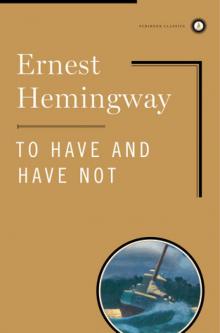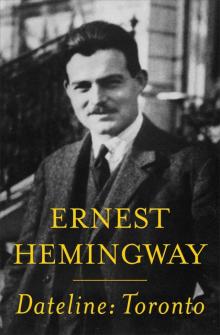- Home
- Ernest Hemingway
Dateline- Toronto Page 46
Dateline- Toronto Read online
Page 46
There are other famous nocturnal places in Paris—Zelli’s, where the newspapermen all used to go, the very dressy dancings in the Rue Caumartin, where one would find Peggy Joyce and other famous ladies of the front page, and sleek-haired Chileans and Argentineans dancing to American jazz music.
Berlin’s nightlife is a great contrast to that of Paris. Berlin is a vulgar, ugly, sullenly dissipated city. After the war it plunged into an orgy that the Germans called the death dance. There is nothing attractive nor gay about the nightlife of Berlin. It is altogether revolting.
If champagne is the deus ex machina of the after-hours existence of Paris, cocaine takes its place in the German capital. Cocaine peddlers get short shrift from the Paris police. But in Berlin they sell their wares openly all over the city. In some cafés cocaine is served at the tables by the waiters.
Berlin is the home of the nightclub. Riding or walking along the street at night, a ragged-looking man will run up to your cab and try to get you to go to a nightclub. A fine new nightclub. All the nightlife of the city.
There is no nightclub in Berlin that is not disgusting, heavy, dull and hopeless. The gaiety is as forced as it is real in Paris on the 14th of July, when the entire city dances in the street for two nights steady and the streets are roped off to shut out taxis and autobuses.
If anyone has any doubt that the Germans lost the war and realize they lost it, all they need would be a session of after-midnight Berlin.
Madrid is another business. Nobody goes to bed in Madrid. On the other hand, they don’t do anything to amuse themselves. They just stay up and talk.
All of the downtown district of Madrid is at its very busiest at two o’clock in the morning. Cafés are crowded. The streets are jammed with people. Theaters start in Madrid at ten o’clock at night. Matinees commence at 6:30 in the afternoon.
There are two big downtown dancing places. One called Maxim’s. The other, two or three doors up the street, I have forgotten the name of. It makes no difference. They are both alike.
Always beware of a place called Maxim’s. It means imitation Paris. Now Paris is a very fine thing. But it doesn’t imitate well. And there are Maxim’s all over the world.
Even the original Maxim’s in Paris is a dull enough place. It has a bar as you go in and then a big room full of tables, with a dancing floor at the far end. It is always full of profiteers, American buyers, and the inevitable sprinkling of South Americans. The music plays loudly and the prices are high. The lights are bright. It is a good place to get a headache.
All the imitation Maxim’s are reproductions on a small scale of the original.
In Madrid I asked a bullfighter where the really gay life of the city was. Where he went himself, for example.
“Me? I go to bed,” he smiled shyly. “I don’t like to talk and I don’t like to drink. Since I have learned to read, I read a little every night in bed before I go to sleep.”
“What do you read?” I asked.
“Oh, the bullfighting papers,” he said.
He is a very serious young man, makes $15,000 a year, and probably has half the girls in Madrid in love with him. But he doesn’t believe in nightlife.
Constantinople before the Mudania armistice was probably the most hectic town in the world. Mustapha Kemal had announced that when he came into town it was going to be shut tight up—and everybody believed him. He had done everything he ever said he would up till then.
Nobody slept much during the day and nobody slept at all during the night. No good restaurants opened up before ten at night and the theaters opened at midnight. The followers of the prophet spent their waking hours trying to make absolutely sure there would be none of the product of Constantinople’s Bavarian breweries left to dump into the Golden Horn when Kemal arrived.
The breweries tried to keep pace with the Moslem demand. It was a great race. Along toward evening, the crews of the British, American, Spanish, Italian and French fleets would come ashore and rush to the aid of the Mohammedans in their struggle with the breweries. It was a great battle, with the brewers always a little ahead. In spite of their smaller numbers, their organization was better.
As the evening advanced fights would break out among the sailors of the different nationalities in the various Galata beer emporiums. This no doubt slowed up their efficiency. Especially when there were shootings or knifings, which occasionally resulted in pitched battles.
All of Constantinople was in a feverish sort of wildness. It had nothing of the sullen ugliness of the Berlin pleasure resorts.
There is the famous incident of the captain of a cruiser of a neutral nation, not the United States, whose vessel was anchored in the Bosporus. The incident came very near to being of tremendous international gravity.
One night at three o’clock in the morning, the commander came aboard his ship. His manner was distrait. His eyes were rolling.
“Clear the ship for action,” he commanded.
The commander paced restlessly up and down the bridge. The ship was as busy as only a warship with its crew suddenly roused at three a.m. can be. Men rushed in every direction. Guns were trained for a broadside.
“Commence firing on the city,” the captain shouted down his telephone from the bridge. “War has been declared.”
Somebody had sense enough to grab him and take him below. Constantinople had been a little too much for him.
The captain was said to have been drinking douzico straight. It has a faculty of making people go crazy at odd times. It is prepared with some sort of strange Turkish ingredients, but its base is grain alcohol imported from the United States in large steel drums. It was never served without some crackers, cheese or radishes to give it something to work on in addition to the lining of the stomach.
From Stamboul across the Golden Horn to the high barren plain at the top of Pera, Constan stayed up all night. Every big newspaper story that broke came after midnight in the nightclubs of Pera. It was in one of these, the Pele Mele, in some way derived from Pall Mall, that an excited young officer just back on a destroyer from Mudania confided the news of the signing of the armistice to a Russian countess who was acting as a waitress.
The officer, who had been present at the signing, told the countess in greatest secrecy because he had to tell someone. He was so excited. She recognized the value of the story and told an American newspaperman whom she liked much better than she did the officer.
In an hour, through means of his own, the newspaperman verified the report, and put it on the cable to New York, where it arrived in time for the morning papers. The signing was not announced officially until next morning at eleven o’clock. By that time the correspondents of the other papers, whose correspondents did not know the countess, were getting cables from New York asking them why they were scooped on Mudania.
Italy is a strange country for nightlife. Nightlife must be taken to mean, not dissipation or dancing places necessarily, but merely that strange, feverish something that keeps people up and about during the hours they would normally sleep.
Milan, the largest city in the north of Italy, with about 800,000 inhabitants, goes to bed almost as early as Toronto does. Verona, not a third as big, is alive and gay at two-thirty in the morning. I remember hiking into Verona with a pack long after midnight expecting to find everything closed tight, and finding the city as alive as Paris at 9:30 in the evening.
Turin is another late town, and a very pleasant town. Rome is very dull at night. Rome, to my mind, is very dull nearly all of the time. It is the last city in the world I would ever want to live in.
Marseilles has one of the most variegated, interesting and toughest night sides in Europe.
Seville, too, is late to bed. So is Granada.
Nightlife is a funny thing. There seems to be no reason or rule that controls it. You cannot find it when you want it. And you cannot get away from it when you don’t want it. It is a European product.
Goiter and Iodine
The Tor
onto Star Weekly
December 15, 1923
Should a whole city be dosed for the ills of a few of its inhabitants?
Across Lake Ontario, Rochester, N.Y., is answering that question in the affirmative by introducing iodine into the city’s water supply in an effort to combat goiter by mass medication.
Rochester is in the heart of the goiter belt that stretches across the freshwater reaches of the North American continent. Goiter, or enlargement of the thyroid gland, is caused according to physicians by a lack of iodine. Most of the iodine of the world is found in the sea. People living near the sea are immune from goiter, the scientists say.
Rochester’s experiment, which is being carried out under the direction of Dr. George W. Goler, health officer, consists in dosing the Kodak City’s water supply with 16.6 pounds of soluble iodine daily over a period of three weeks twice a year. This is fifty parts of iodine to a billion parts of water.
It is said to be such a small amount of the drug that its presence cannot be determined even by chemical analysis. But the scientists conducting the experiment believe it will successfully prevent goiter.
When the wholesale dosing was decided on, a notice was posted in the city schools of Rochester stating: “We are putting fifty parts of iodine per one billion parts of water in the Hemlock water supply for prevention of goiter. If you are under twenty years of age, drink three or four quarts of water a day and see your goiter disappear.”
Toronto, although it is in the goiter belt and has as large a percentage of cases of the disease as Rochester, has no intention of adopting the mass method, according to Dr. C. J. O. Hastings, of the Department of Public Health.
Dr. Hastings would not comment on the Rochester experiment beyond stating that it had not been tried and was not contemplated in Toronto. Dr. Hastings believes the treatment of goiter among children should be handled by the family physician.
“Goiter is a deficiency disease,” Dr. Hastings stated. “It is due to insufficient iodine content in our food and drink. This has been shown by demonstration that enlargement of the thyroid gland can be readily produced by entirely eliminating iodine from our food and water supply. Another proof is the demonstration that goiter can be prevented and cured by the proper administration of iodine in a form that can be assimilated by our system. That is, by giving a small medicinal dose of some officinal preparation of iodine such as syrup iodide of iron or iodide of sodium for a period of say two weeks in spring and fall.”
A year ago Dr. Hastings stated the percentage of goiter in Toronto schoolchildren was as high as fifteen to twenty percent in one school ranging down to two percent in another. Since then no new survey has been made so the increase or decrease of the disease can only be conjectured.
Since earliest times medical men have faced the problem of goiter. Out of the age-long struggle certain facts have emerged.
Goiter, or thick neck, is an enlargement of the thyroid gland that lies across the front of the neck. The thyroid is necessary for the growth of children. If it cannot get iodine in some form or other, this gland swells and enlarges.
It is the great preventive of goiter. The sea is where the iodine of the world is stored. In other days our table salt came from the sea and contained all the iodine that was needed by the human body. Now it often comes from inland salt mines.
People who live in high mountainous countries, where whatever iodine may have been deposited when the waters receded from the earth has been almost completely washed away by melting snow and glaciers, are the most gravely affected with goiter. In Switzerland the disease is almost universal among the men and women of the mountains. In the Canton of Zurich one district was found to be one hundred percent goiterous.
The further one gets from the sea the more prevalent does goiter become.
Along the seaboard, on the other hand, the disease almost never appears.
The North American continent is, by some students of the goiter problem, divided into four goiter belts. These run across from east to west. The southern and eastern coast has practically no goiter. North in the plains and Ohio valley there is a certain amount of the disease. Then comes a belt where it is more frequent, including the middle and western states.
In the high ground of the Great Lakes, in cities such as Chicago, Buffalo, Rochester, Toronto and Detroit and in the mountainous regions of the West, goiter is most prevalent.
All water contains a certain amount of iodine, except in the most goiter-ridden parts of the world such as the Swiss, Tyrolean and Trentino Alps. In parts of these districts, the natives drink from glacial streams which contain nothing but snow water.
Dr. J. P. McClendon, professor of physiological chemistry in the University of Minnesota Medical School, says that eating seafood on Fridays and holidays at the seashore is a goiter preventive. All marine animals and plants contain iodine and the necessary anti-goiter drug can be obtained through eating fish, according to the professor.
He advises the inhabitants of the goiter belt to give children a little powdered kelp, seaweed, or other iodine-containing material mixed with their food, water or salt.
Dwellers along the seacoast escape goiter because of the way the sea-water is thrown into spray in great storms and blown inland great distances. Iodine in sea salt is sometimes blown land-ward a distance of 200 miles, scientists state.
Dr. H. A. Stevenson, of London, is a pioneer in advocating iodine treatment as a public health measure in Ontario. Prominent Ontario physicians have pointed out the numberless bad effects from thyroid enlargement. Nervousness, irritability, lack of balance, and various conditions are the result of overdevelopment of the thyroid gland, which could be controlled by iodine administration.
Dr. Stevenson, in 1921, while an M.P.P., advocated regular treatment in the public schools in order to secure a normal development of the thyroid gland to commence with a survey of schoolchildren of the province. His proposal seemed too new and did not meet with instant approval.
Human beings are not the only sufferers from goiter. Sheep, cattle, hogs, dogs and fish are all liable to the disease.
Dr. Hastings tells of one of the first practical demonstrations of goiter prevention in Michigan. A large flock of sheep were afflicted with goiter. Their condition seemed hopeless. But they found in a new pasture a bed of crude salt and after licking it soon recovered. No further cases of goiter developed. The salt was analyzed and found to contain a great quantity of iodine.
Brook trout have been heavy sufferers from goiter. At one time the malady became so prevalent among government hatcheries and the fish died off to such an extent that it was believed artificial trout raising would have to be abandoned.
Investigators discovered that the artificial food the trout were getting was free from iodine content. When a small amount of iodine was added, the fish became normal again.
Rochester’s experiment in goiter prevention by mass medication was only undertaken after consultation with the leading scientists and authorities of the city. Investigation showed that Rochester used 24 million gallons of water a day. There was already two parts of iodine in a billion parts of water.
Difficulty was encountered in diffusing the iodine properly through the city’s entire water supply but the fact that the water fed through ten miles of pipes from one reservoir to another helped this out.
“The amount of iodine taken is so small that it cannot be harmful to a normal person,” Dr. Goler, the Rochester health officer, told a reporter for a New York paper. “But in this region, where iodine is not obtained in either water or salt, everyone is deficient in iodine. This deficiency does not manifest itself in everyone in the same manner.
“In some it causes goiters but we do not know how greatly this lack of iodine may affect our health in other ways. There is not the slightest danger of getting too much iodine during the six weeks of the year it is in the water, even if one drinks it who comes from a region where there was enough iodine in the water and who consequently has
plenty of iodine in his system.”
About 300,000 people get their drinking water in Rochester from the city waterworks. A private water company supplies about 37,000 people with water from Lake Ontario. So far no iodine has been placed in Lake Ontario.
“We have in this country caused many diseases to disappear, including typhus, cholera, yellow fever and smallpox,” Dr. Goler is reported to have stated.
“Other diseases are in the process of disappearing. These include malaria, typhoid and diphtheria.
“We know that iodine will prevent goiter. When a million pigs died from goiter, they began feeding them iodine. Should we not do as much for ourselves and our children as we have already done for fish and pigs by adding a little iodine to their drinking water?”
I Like Americans
The Toronto Star Weekly
December 15, 1923
I like Americans.
They are so unlike Canadians.
They do not take their policemen seriously.
They come to Montreal to drink.
Not to criticize.
They claim they won the war.
But they know at heart that they didn’t.
They have such respect for Englishmen.
They like to live abroad.
They do not brag about how they take baths.
But they take them.
Their teeth are so good.
And they wear B.V.D.’s all the year round.
I wish they didn’t brag about it.
They have the second-best navy in the world.
But they never mention it.
They would like to have Henry Ford for president.

 The Old Man and the Sea
The Old Man and the Sea Green Hills of Africa
Green Hills of Africa The Sun Also Rises
The Sun Also Rises Death in the Afternoon
Death in the Afternoon In Our Time
In Our Time For Whom the Bell Tolls
For Whom the Bell Tolls A Farewell to Arms
A Farewell to Arms A Moveable Feast
A Moveable Feast The Complete Short Stories of Ernest Hemingway
The Complete Short Stories of Ernest Hemingway Big Two-Hearted River
Big Two-Hearted River Winner Take Nothing
Winner Take Nothing Islands in the Stream
Islands in the Stream To Have and Have Not
To Have and Have Not The Snows of Kilimanjaro and Other Stories
The Snows of Kilimanjaro and Other Stories Across the River and Into the Trees
Across the River and Into the Trees By-Line Ernest Hemingway
By-Line Ernest Hemingway True at First Light
True at First Light Men Without Women
Men Without Women The Nick Adams Stories
The Nick Adams Stories Dateline- Toronto
Dateline- Toronto The Torrents of Spring
The Torrents of Spring Short Stories
Short Stories